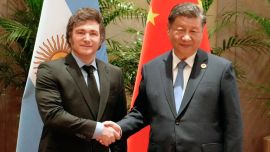The Buenos Aires Herald is dead. Long live the Buenos Aires Times.
Shakespeare asked in the voice of Juliet: “What’s in a name? That which we call a rose, by any other name would smell as sweet.”
So, what’s in a name? Unfortunately, the real Herald needs a new name because the media group that says it owns the name hopes to profit by selling what remains of the newspaper, which ceased publication a month ago.
It was killed off on July 31, 2017, after 141 years fighting for an open and democratic Argentina.
By “the real Herald” I mean the soul and spirit of the democratic newspaper along with a constellation of journalists and faithful readers that continued to exist after December 30, 2007. That was the day when Sergio Szpolski acquired the newspaper in murky circumstances.
The name Szpolski is notorious, particularly among journalists. I have seen him described as a “media mercenary” operating for the Kirchners; but a better description might be “media assassin” of newspapers, magazines and radio stations. He has a reputation for leaving media groups in bankruptcy and journalists in the street without pay or pension contributions.
Szpolski didn’t kill the Herald outright. He used a poison pill to strip the paper of its assets, demolishing its graceful building, designed by a fine architect, that housed the newsroom, offices, reception area and ground-floor printing plant. There is speculation about how much money he made from the murder of the Herald. The land on which the legendary newspaper building stood was valued at more than US$3 million. The editor at the time, Andrew Graham-Yooll, was close to retirement age. He walked away, rather than work for Szpolski, but the reminder of the staff really had no option but to stay.
The media assassin then sold what was left — the name and what remained of the archives — to Ámbito Financiero, in whose embrace the paper thrived for a while, although the staff had to move to cramped quarters at Paseo Colon 1196, seven blocks away from the spacious, conveniently situated newsroom at Azopardo 455. It was almost literally only a few steps from Plaza de Mayo, the Casa Rosada, and the main government ministries. It was perfectly located for covering the 1976 coup, counting how many Ford Falcon death squad cars were parked outside Balcarce 50 and keeping a protective eye on the Madres of the Plaza de Mayo as they circled the pyramid.
I thought, at first, that the Herald was back in good hands after meeting the majority shareholder of the Grupo Ámbito, Orlando Vignatti. A guarantee was that Carolina Barros-Moss had been appointed editor-in-chief. I was invited to write again for the paper and I gladly accepted. But the good times did not last. When Carolina departed, it gradually became clear to me that the Herald, despite the efforts of its staff to keep the paper on track was no longer in tune with its past. The paper that had made its name through writing in English what the other newspapers covered up in Spanish, was covering up for a government that, in my opinion, was becoming increasingly authoritarian and anti-democratic.
The last straw, for me, was the newspaper’s slanted reporting of the murder or suicide of special prosecutor Alberto Nisman, who was found dead of a gunshot wound to the head just a day before he planned to denounce a government cover-up of the terrorist attack on the AMIA Jewish community centre. I was also disappointed by the newspaper’s laudatory acceptance of the preposterous claim that the Kirchner era was a splendid decade (“una década ganada”), while showing reluctance to look into charges of government corruption. It was encouraging that the newspaper remained committed to human rights and did some fine reporting, particularly on the criminal trials of the dictatorship. But, finally, when a majority of the Herald’s shares were acquired by Grupo Indalo, headed by Cristóbal López, I decided that I could not, in all decency, continue to write for the newspaper. I still enjoyed the paper, which retained its character and as much of its integrity as was possible because it still had good journalists, although they were workings under restraint.
So it was a sad day when the Buenos Aires Herald, by then a weekly paper, was abruptly closed down on July 31, 2017, only a month and a half short of the newspaper’s 141st anniversary. It is not an exaggeration to say that the world of journalism mourned. However, the curtain has not come down forever. The curtain is to rise again.
Looking back, I think it’s fair to say that the Herald’s greatest years began when a newspaper group in Charleston, South Carolina, purchased the paper in November 1968. They cherished it for almost 40 years, re-investing all profits in stabilizing and improving the newspaper while it was making money and subsidising the paper when it began to lose money. I was told that at one point the Charleston group was pumping in from US$500,000 to US$1,000,000 a year to keep the paper running. That must have been alarming because in the mid-1980s, one of the Charleston owners actually boasted to me that the Herald was US$1 million a year in the black. At first, the purchase of the paper by a US media group did not seem to me to be a good idea.
‘The curtain has not come down forever. The curtain is set to rise again.’
For one thing, the Herald had a profit-sharing scheme that gave every employee a financial stake in the company. The new owners announced that they intended to plough all profits back into the newspaper. We were also proud to be a national newspaper and one of our slogans was that it was an Argentine newspaper written in English. But, as it turned out, US ownership of a majority of the shares was a godsend.
The paper had always been proudly independent and pro-human rights, long before the term became current. It was also firmly anti-fascist while its rival, The Standard, favoured the Axis during World War II at the same time that the Herald fervently supported the Allies. But the newspaper’s storied history did not grant it immunity when the military seized power. There were no local or national circumstances imaginable during the 1976-84 dictatorship that could have provided the independence and protection that was forthcoming from a newspaper family with conservative roots, deep in the US South.
The Buenos Aires connection with Charleston, South Carolina began as a romantic affair. Peter Manigault, heir to the (Charleston) Evening Post Publishing Company was the first Manigault to be educated outside Charleston. He went to Princeton. He came to Argentina first as a US Navy officer. Later he travelled widely in Latin America, reporting for the family’s papers in Charleston. Then he fell in love with Argentina. The Herald benefitted from that love affair for 40 years.
Most importantly, Peter gave us journalists complete independence. “Just do your job,” he said. There was never even a hint that we should go with the media herd and ignore the forced disappearances and the other horrors of the dictatorship that I now believe must be recognised as a form of genocide. Now history seems to be repeating itself. This time another “family firm” is about to embrace the surviving soul and spirit of a newspaper that has been virtually stripped of its name. Editorial Perfil has come to the rescue.
Editorial Perfil’s founder and CEO is Jorge Fontevecchia and there is a strong tie to the old Buenos Aires Herald. It was formed in dramatic circumstances that perhaps will eventually play out into another love story, echoing the romance of Peter Manigault with the Herald. There is already a kind of kinship between Perfil and the pre-Szpolski Herald. It stems from the role that the paper played in an episode in the life of Jorge Fontevecchia. The story is worth retelling because it is not only a necessary reminder of the radical evil of the dictatorship, but it also throws a light on what I call “indecent journalism.”
In 1979, after the lights went out in most of the media, an entertainment magazine called La Semana attracted my attention. It had the temerity, under its very young editor Jorge Fontevecchia, to ignore the military’s prohibitions and continue to carry stories about black-listed artists like Mercedes Sosa. Then, one day the young Fontevecchia was kidnapped in the street outside his office. We got the news through a hand-delivered letter from Jorge’s father. We were able to alert the world and thankfully he emerged from the hell of El Olimpo, a clandestine prison where torture was routine and from whence many were sent to be murdered. That was extraordinary enough. But, what I discovered much later on was, perhaps, even more disturbing because Argentina was now a democracy.
When I was visiting Buenos Aires in 2012, a celebrated journalist tried to convince me that the kidnapping and narrowly averted murder of Fontevecchia had never happened. I had a forewarning because I had personal knowledge of the campaign, conducted from one of Szpolski’s magazines to destroy Fontevecchia’s reputation by claiming that he had been a supporter of the military government and that the story of his kidnapping and the passage through the hell of El Olimpo was made up. It was an outrageous example of the use of “The Big Lie.”
I have learned a few basic truths about newspapers over the years and I know that they will continue to apply, whatever platform is devised to deliver the news that people must have in order if democracy is to work. The first is that a newspaper, or whatever it may be called, will only be as good as the journalists who work for it. The second is that there can be no good journalism without principled owners.
So, what’s in a name? The newspaper you have in your hands today will be just as good, maybe better, than the paper you knew as the Herald. It is in good hands and many of the people who worked for that great little newspaper are back, free after a difficult decade. They will play their part. Whether or not your new paper succeeds is up to you, dear reader.
Long live the Buenos Aires Times.
























Comments